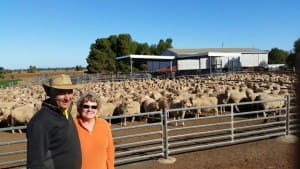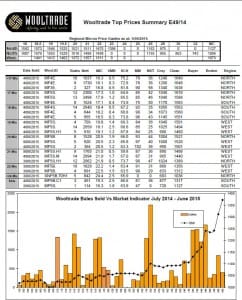West Wyalong woolgrowers Jeff and Elizabeth Gould have made Wooltrade an integral part of their cropping-wool business model.
The Gould’s main business is cropping, over about 1700 hectares, but they also run just over 2000 Kenilworth-blood Merinos on about 285 hectares, producing about 60 bales of wool a year.
“I have a great belief in the wool industry and we’ve been purchasing rams from Tasmania for about 18 years.
“We’ve got a good team behind us; I’ve been selling through Jemalong Wool since I left school.”
Wool is stored to to be marketed as market lifts
Mr Gould said the flock’s oddments are sold annually on the physical market to meet immediate costs, but the fleece wool is valued as a “backstop” to the cropping operation, with lots sold progressively on Wooltrade as prices spike.
Mr Gould said his business model enabled him to keep wool specifically for these spikes and as a security for any potential fall in cropping income.
“If the price is not right we just put it on hold.
“We utilise wool as a backstop,” he said.
“We put a lot through auction, but because wool has been the way it has for the past 10 years we just hold it up and when the job’s right we sell it – if it doesn’t go it doesn’t matter.”
Mon Repose line tops Wooltrade 20-micron category
As the physical market surged last week, with the AWEX-Eastern Market Indicator hitting 1373, the Gould’s brand, JT& EA/Mon Repose through Jemalong Wool, topped Wooltrade’s 20-micron category with an 8-bale 20.5 micron fleece wool line that sold for 1528c/kg clean. The line yielded 66pc with a staple length of 93mm, tensile strength of 44 Newtons/kilotex and 1.9pc vegetable matter content.
Mr Gould said he was prepared to store wool and wait for prices to reach his “markers” or realistic reserves, sometimes setting up to three price markers across various lines from 30-120c/kg above the physical market levels.
“If it doesn’t reach those benchmarks then it doesn’t go.
“I don’t believe the wool has hit where it is going to hit; I believe there is plenty of room north of where we are,” he said.
Wool price at level that justifies flock maintenance
Mr Gould said the recent price rises have enabled them to sell about two years’ wool production in the last 12 months, mostly in recent weeks. But Mon Repose still has a couple of year’s production in storage and recent wool prices are not sufficient to lift sheep numbers beyond his planned gradual increase.
“We never change in a rush, only in increments. We don’t buy stock in, except for rams, so it is just natural increase here,” he said.
“I won’t say this (price increase) is a flash in the pan, because it will last longer than that, but the wool industry is very cyclical and this is just another cycle.
“It may last longer than most because the Merino numbers are not on the ground – there are just enough people gone into Dorpers, goats and cattle now to make it worthwhile for the rest of us to maintain what we are doing.”
Wooltrade market operations officer Tom Rookyard said the price rise last week was the third largest gain since the wool market kicked in April.
Finer types firmed on Wooltrade last week, he said, with the 16 micron lines making to 1649c/kg clean and the 17 micron wools selling to 1610c/kg. The 18 micron wool sold to 1563c/kg, up 40 cents, and the 19 micron lines made to 1501c/kg, a 50 cent lift.
Mr Rookyard said the 20 micron wools lifted 70 cents, but the biggest increase of 100 cents came in the 21 micron lines, which made to 1488c/kg, and in the 22 micron fleece, that sold to 1356c/kg.
“With 35,000 bales on offer this week nationally at the physical auctions, anticipation is rampant to see if these levels will be maintained,” Mr Rookyard said.



HAVE YOUR SAY